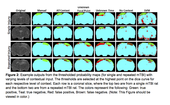Highlight
Contextual and Visual Modeling of Mild Traumatic Brain Injury
Achievement/Results
The NSF IGERT on Video Bioinformatics at the University of California, Riverside has developed visual and contextually driven algorithms for detecting low contrast lesions, in magnetic resonance images, caused by mild traumatic brain injury (mTBI). This allows for automated algorithms that are not affected by inter-operator variability or fatigue. Due to the low contrast nature of mTBI lesions, a contextually driven Bayesian network is developed that is able to simulate the progression of the lesion with various contextual inputs such as the time since the injury and time between repeated injuries.
Some examples of the low contrast lesions are shown in Figure 1. The contextual model is combined with a novel voxel based classifier that uses texture features to estimate the composition of tissue at a given voxel. The algorithms were tested using a controlled cortical impact rat spatio-temporal dataset. The subjects were processed in minutes, which allow this approach to be incorporated in practical workflow without hindrance. Each contextual input was tested to evaluate its contribution. Figure 2 show examples outputs from the system with various levels of contextual input. This algorithms were compared to state-of-the-art algorithms and were shown to significantly outperform in both detection and computation time. This work was carried out through the collaboration between two biologists (Virginia Donovan and Andre Obenaus) and two Electrical Engineers (Anthony Bianchi and Bir Bhanu).
References: A. Bianchi, B. Bhanu, V. Donovan, A. Obenaus, “Visual and Contextual Modeling for the Detection of Repeated Mild Traumatic Brain Injury.” IEEE Transactions on Medical Imaging, In Review April 2013.
A. Bianchi, V. Donovan, B. Bhanu, A. Obenaus, “Contextual and Visual Modeling for Detection of Mild Traumatic Brain Injury in MRI.” IEEE International Conference on Image Processing, Orlando, FL, October 2012.
Address Goals
This is the first work on developing fully automated computational methods for repeated mild traumatic injury, a topic that is significant and it is in the news almost every day. This work was carried out through the collaboration between two biologists (Virginia Donovan and Andre Obenaus) and two Electrical Engineers (Anthony Bianchi and Bir Bhanu).







